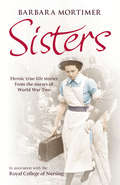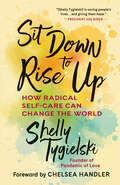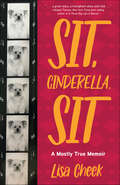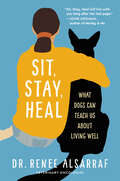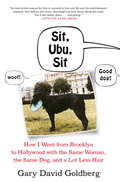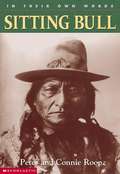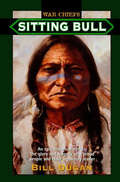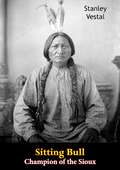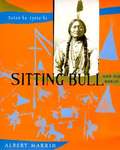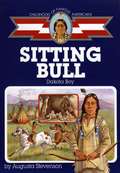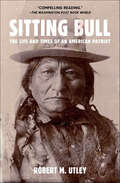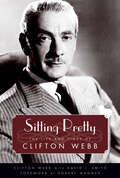- Table View
- List View
Sisters of the East End
by Helen BattenHeart-warming tales of nursing and midwifery from the Sisters who worked with Jennifer Worth.‘A second’s silence and then an almighty scream. It was the most moving thing I had ever seen … A baby, a real live baby, another human life had entered the world. It didn’t seem possible and yet I had witnessed it with my very own eyes.’Born into a happy working-class North London family in the mid-twentieth century, Katie is determined to ‘do something’ with her life. Working in the impoverished East End in the 1950s, she meets the Sisters of St John the Divine – a community of nuns dedicated to nursing and midwifery. The Sisters have been present at births, cared for the sick and laid out the dead of the East Enders for a hundred years, and Katie soon joins them to start her journey to becoming Sister Catherine Mary. As a nurse and midwife, Katie learns to deal with everything from strokes to breech births. Tragedy is never far away, but there are also moments of pure joy as lives are saved and the Poplar residents rally round. As a young novice Katie rallies against the vow of obedience, yet over the years learns much about the nature of dedication and love.Full of desperate hardship, humour and compassion, Katie’s story brings to life the unique world of these nursing Sisters in London’s East End. Sister Catherine Mary’s story was written by Helen Batten after in-depth interviews with today’s Sisters of the Community of St John the Divine.The Community of St John the Divine was founded in 1848 in a bid to make nursing a respectable profession. Early Sisters worked in the Crimea with Florence Nightingale and were instrumental in developing recognised training and qualifications for nurses and midwives. In the early 20th century they were working in areas such as Poplar and Deptford becoming a treasured part of the community. Today the Sisterhood is based in Birmingham and their website is www.csjd.org.uk.Helen Batten studied history at Cambridge and then journalism at Cardiff University. She went on to become a producer and director at the BBC and now works as a writer and a psychotherapist. She lives in West London with her three daughters.
Sisters: Heroic true-life stories from the nurses of World War Two
by Barbara MortimerOn 3 September 1939, the Prime Minister declared that Britain was at war with Nazi Germany.Thousands of young women, many of them barely out of school, were sent headlong into gruelling training regimes that would see them become wartime nurses. Sisters features over 150 previously unpublished stories from the archives of the Royal College of Nursing. The vivid, poignant and riveting stories capture these nurses' incredible bravery and touching friendships.
Sisters: The Lives of America's Suffragists
by Jean H. BakerJean H. Baker's Sisters shows how the personal became political In the fight to grant women civil rights.They forever changed America: Lucy Stone, Susan B. Anthony, Elizabeth Cady Stanton, Frances Willard, Alice Paul. At their revolution's start in the 1840s, a woman's right to speak in public was questioned. By its conclusion in 1920, the victory in woman's suffrage had also encompassed the most fundamental rights of citizenship: the right to control wages, hold property, to contract, to sue, to testify in court. Their struggle was confrontational (women were the first to picket the White House for a political cause) and violent (women were arrested, jailed, and force-fed in prisons). And like every revolutionary before them, their struggle was personal.For the first time, the eminent historian Jean H. Baker tellingly interweaves these women's private lives with their public achievements, presenting these revolutionary women in three dimensions, humanized, and marvelously approachable.
Sit Down to Rise Up: How Radical Self-Care Can Change the World
by Shelly TygielskiAn empowering treatise on propelling profound social change by going inward, from a mindfulness teacher and activist who has turned personal practice into movements The practice of mindfulness is most often touted for its profound mind, body, and spirit benefits. Shelly Tygielski here shows that mindfulness can also be a powerful tool for spurring transformative collective action. In a winning combination of memoir, manifesto, and how-to, Tygielski shares her evolution from a Jerusalem-born child of traditional Sephardic Orthodox parents to a middle-class American suburban youth who questioned her faith to a young executive in corporate America. As she used self-help practices to heal from chronic health issues and a messy divorce, she had an epiphany: finding true health and peace is not a solo endeavor but one that lives in connection with others. Tygielski considers herself an unlikely meditator, activist, and teacher. But in that way she is uniquely qualified to speak to all today who wonder, &“What can I do?&” or &“Will my actions even make a difference?&” Tygielski&’s work began as &“me&” work and transformed into &“we&” work. In Sit Down to Rise Up, she shows that this is possible for all of us.
Sit Down to Rise Up: How Radical Self-Care Can Change the World
by Shelly TygielskiIn Sit Down to Rise Up, mindfulness teacher and activist Shelly Tygielski shares her transformative journey of radical self-care and mutual aid, illuminating how these practices can ignite powerful social change and personal empowerment. Through stories and practical guidance, she demonstrates the profound impact of showing up for yourself and your community. This book is a blueprint for anyone seeking to cultivate resilience, compassion, and a sense of purpose in a fractured world. Discover how small acts of kindness can create ripple effects that lead to broader movements for justice and equity and how, despite the challenges we face, we should never lose hope or lose faith in humanity. Join Shelly in exploring how every human life matters and how together, we can rise up to build a better future.
Sit Stay Heal: How an Underachieving Labrador Won Our Hearts and Brought Us Together
by Mel MiskimenRowdy, reckless Seamus is the last dog you'd find in a training field. Instead of obediently retrieving, he stubbornly follows his heart, wherever it may lead.Mel Miskimen's heart is heavy. Her mom, the family rock, the provider of apple pies and stubborn fan of Brett Favre, just died. Even more, her curmudgeon of a father isn't really coping. How can Mel reconnect with an old man more interested in field dog training than discussing his feelings? Enter Seamus. The hapless black lab throws their grief into joyful disarray. Mel encourages her dad to mold Seamus into a champion retriever.. But as the seasons change, and memories follow, Mel realizes she must face her own fears, and that the road to Seamus's field trials might just heal them all. At turns hilarious and heart breaking, Sit Stay Heal will touch the souls of dog lovers everything, and speak to anyone seeking a way to connect with those they've lost.
Sit, Cinderella, Sit: A Mostly True Memoir
by Lisa CheekA debut memoir and (sort of) Cinderella story about a woman who’d been told she was “too old” to create magic who flew to rural China, edited a film without speaking a word of Mandarin, and discovered her own power. Lisa Cheek loved editing TV commercials—almost as much as she loved her dog, Ron Howard. Then, she “aged out” of advertising, at 45. After being let go, Lisa got a call—at 2:45 AM—from a director who, like everyone in Hollywood, had a film he wanted to make: the original Cinderella story. Now, his dream could come true—if Lisa granted his wish. In Sit, Cinderella, Sit, Lisa Cheek shares her adventures in editing a film made on location in China—along the Tibetan border—where Mandarin was the only language spoken by everyone but her. Stuck in a house with fourteen men she couldn’t understand, literally, she yearned for conversation and coffee. But there were moments of wonder and laughter. Lisa forged a bond with her translator and a woman named Sunny. She rescued one dog, and then another. “Everyone speaks Cinderella,” the director had assured her. Maybe he was right. Told with humor and heart through a fairy tale lens, with flashbacks into the author’s not-always-happy childhood, Sit, Cinderella, Sit is a story about what can happen when you take a leap of faith, look and hear beyond people’s differences, and dare to believe in yourself.
Sit, Stay, Heal: What Dogs Can Teach Us About Living Well
by Renee Alsarraf“Written with grace and emotional honesty, Sit, Stay, Heal will live with you long after the last page.”— John Grogan, bestselling author of Marley & MeFor more than two decades, esteemed veterinary oncologist Dr. Renee Alsarraf treated cancer in her beloved canine patients. Then, at age fifty-one, she was diagnosed with cancer herself.Sit, Stay, Heal: What Dogs Can Teach Us About Living Well is Dr. Renee’s unforgettable testament to the extraordinary healing nature of dogs. Every day in her veterinary practice, she bears witness to the undeniable bond between pets and their people. However, while we are busy teaching them to “sit” and “stay,” they have their own, more profound, lessons to impart. In Sit, Stay, Heal, we meet Cosmo, the golden retriever who arrives at Renee’s office just before his fourteenth family vacation to the beach; Daisy, the cocker spaniel, an emotional support dog for a special needs child; and Franny, the bloodhound, a police dog who wasn’t ready to retire from the force. Then there’s Dr. Renee’s own dog Newtie, who falls ill when she needs him most.Our dogs are wise in ways humans are not. For Dr. Renee, it was her patients—those furry, four-legged, slobbering animals—who seemed to uniquely understand her difficult journey and who showed her the true power of positivity and unconditional love. Full of life lessons and healing metaphors, perfect dogs and their imperfect humans, Sit, Stay, Heal is a captivating, heartwarming story for dog lovers far and wide.
Sit, Ubu, Sit: How I Went from Brooklyn to Hollywood with the Same Woman, the Same Dog, and a Lot Less Hair
by Gary David GoldbergA sports-crazed kid from Bensonhurst, Brooklyn, Gary David Goldberg never imagined he'd end up in Hollywood, let alone make it big there. But as a twenty-five-year-old waiter in Greenwich Village he met Diana, the love of his life; followed her out to Northern California; then moved in and never moved out. He also, without realizing it, put himself on track to found UBU Productions (named after his beloved Labrador retriever) and become a successful creator of such family sitcoms asFamily Ties,Brooklyn Bridge, andSpin City. * InSit, Ubu, Sit, award-winning writer/producer Goldberg tells the mostly upbeat, sometimes difficult, and frequently hilarious tale of his improbable career and the people who have filled it. A love story and a rare behind-the-scenes look at the entertainment industry,Sit, Ubu, Sitproves that it is possible to be creative and successful while holding on to your integrity, your family, and your sense of humor. *with Bill Lawrence From the Hardcover edition.
Sit, Walk, Don't Talk: How I Survived a Silent Meditation Retreat
by Jennifer HowdJennifer Howd had been building a mindfulness practice for a few years before taking on the challenge of her first nine-day silent meditation retreat. In this debut memoir, she chronicles the humorous--and often harrowing--adventures of the dueling inner voices that emerge in the silence: one intent on focusing on the seemingly negative aspects of her experiences, and the other on helping her see the positivity that can come from them.Illuminating for those who are new to mindfulness and resonant for those with established practices, Sit, Walk, Don’t Talk: How I Survived a Silent Meditation Retreat also includes a helpful appendix listing tips for preparing for a silent meditation retreat, including a section for undertaking a retreat on your own.Sit, Walk, Don't Talk is written from a secular perspective and will appeal to folks who've never attended a residential retreat but are curious about the experience and want to get a taste of what to expect before possibly taking the plunge. Practitioners who dream of going on retreat but cannot make the time will also get a lot out of Howd's story, as well as folks who've been on many retreats and want to recapture the feeling without leaving home.
Sites of the Unconscious: Hypnosis and the Emergence of the Psychoanalytic Setting
by Andreas MayerIn the late nineteenth century, scientists, psychiatrists, and medical practitioners began employing a new experimental technique for the study of neuroses: hypnotism. Though the efforts of the famous French neurologist Jean-Martin Charcot to transform hypnosis into a laboratory science failed, his Viennese translator and disciple Sigmund Freud took up the challenge and invented psychoanalysis. Previous scholarship has viewed hypnosis and psychoanalysis in sharp opposition or claimed that both were ultimately grounded in the phenomenon of suggestion and thus equally flawed. In this groundbreaking study, Andreas Mayer reexamines the relationship between hypnosis and psychoanalysis, revealing that the emergence of the familiar Freudian psychoanalytic setting cannot be understood without a detailed analysis of the sites, material and social practices, and controversies within the checkered scientific and medical landscape of hypnotism. aaaaaaaaaa"Sites of the Unconscious" analyzes the major controversies between competing French schools of hypnotism that emerged at this time, stressing their different views on the production of viable evidence and their different ways of deploying hypnosis. Mayer then reconstructs in detail the reception of French hypnotism in German-speaking countries, arguing that the distinctive features of FreudOCOs psychoanalytic setting of the couch emerged out of the clinical laboratories and private consulting rooms of the practitioners of hypnosis.
Sito: An American Teenager and the City that Failed Him
by Laurence RalphA riveting and heart-wrenching story of violence, grief and the American justice system, exploring the systemic issues that perpetuate gang participation in one of the wealthiest cities in the country, through the story of one teenager. In September of 2019, Luis Alberto Quiñonez—known as Sito— was shot to death as he sat in his car in the Mission District of San Francisco. He was nineteen. His killer, Julius Williams, was seventeen. It was the second time the teens had encountered one another. The first, five years before, also ended in tragedy, when Julius watched as his brother was stabbed to death by an acquaintance of Sito&’s. The two murders merited a few local news stories, and then the rest of the world moved on. But for the families of the slain teenagers, it was impossible to move on. And for Laurence Ralph, the stepfather of Sito&’s half-brother who had dedicated much of his academic career to studying gang-affiliated youth, Sito&’s murder forced him to revisit a subject of scholarly inquiry in a profoundly different, deeply personal way. Written from Ralph's perspective as both a person enmeshed in Sito's family and as an Ivy League professor and expert on the entanglement of class and violence, SITO is an intimate story with an message about the lived experience of urban danger, and about anger, fear, grief, vengeance, and ultimately grace.
Sitting Bull
by Chris HayhurstSitting Bull first went to battle at the age of 14. He grew to be widely respected for his bravery and insight, and became chief of the Lakota nation in his thirties. By the time he met General Custer at the Battle of the Little Bighorn, his courage was legendary. Though he soundly defeated Custer, public outrage at the defeat brought thousands of cavalrymen to the area, where it took four more years before the brave chief would surrender. He was forced onto a reservation where he was later killed when police attempted to arrest him.
Sitting Bull
by Peter Roop Connie RoopA proud father and a brave warrior, Sitting Bull wanted the Lakota Sioux to continue hunting buffalo and roaming the Plains. He is remembered for his brave actions and notable accomplishments in this new biography.
Sitting Bull
by Herman J. ViolaA biography of the American Indian who engineered the defeat of Custer and his troops at Little Big Horn and toured with Buffalo Bill's Wild West Show.
Sitting Bull (War Chiefs #5)
by Bill DuganWhen the gold-struck Northwest was opened up to settlement, westward expansion progressed from a trickle to a flood, devastating everything--and everyone--in its path. The Sioux and the Cheyenne knew that the hordes of settlers had to be stopped. But nothing--not even their peace-making attempts--could quell the greedy desires of the white man for land. Dependent upon buffalo for their livelihood, the Sioux found the great herds divided by the new railroad tracks and threatened on all sides by blue-uniformed soldiers. Soon, this proud people would find themselves drawn into a long, bloody battle against these soldiers, many hardened veterans of the Civil War. Only Sitting Bull had the courage to fight back, defying the inevitable consequences. In the aftermath of the disastrous battle of the Little Big Horn, Sitting Bull was ready to lead his people in one last try at self-determination--and survival. Impeccably researched, rich with real-life characters and period detail, this powerful historical novel vividly recounts the fall of the Sioux Nation and its inimitable leader, Sitting Bull, who heroically attempted to preserve his people's way of life in the face of overwhelming odds.
Sitting Bull Champion of the Sioux
by Stanley Vestal"If that is Long Hair, I am the one who killed him," White Bull, the young nephew of Sitting Bull, said when Bad Juice pointed out Custer's body immediately after the Battle of the Little Big Horn. Yet it was Sitting Bull who acquired the notoriety and was paraded in Buffalo Bill's Wild West Show as "the warrior who killed Custer." But this new edition of Stanley Vestal's classic biography of the famous chief emphasizes that "Sitting Bull's fame does not rest upon the death of Custer’s five troops. Had he been twenty miles away shooting antelope that morning, he would still remain the greatest of the Sioux."The stirring account of the death throes of a mighty nation and its leader is the story of the "greatest of the Sioux" and his struggle to keep his people free and united. The Sioux were formidable warriors, as attested to by men who fought against them, like General Anson Mills, who said, "They were the best cavalry in the world; their like will never be seen again," but they were up against an overwhelming tide of soldiers, homesteaders, and bureaucrats. Sitting Bull fought long and hard and "He was ... a statesman, one of the most farsighted we have had," but statesmanship could not prevail against such odds.-Print ed.
Sitting Bull and His World
by Albert MarrinRichly researched, told with sweep, speed, and balance, here is a biography of the man who was arguably the Plains Indians' most revered, most visionary leader. Tatan'ka Iyota'ke--Sitting Bull--was the great Hunkpapa Lakota chief who helped defeat Custer at the Battle of the Little Bighorn. But more than that, he was a profound holy man and seer, an astute judge of men, a singer and speaker for his people's ways. In the face of the army, the railroad, the discovery of gold, and the decimation of the buffalo, he led his band to Canada rather than "come in" to the white man's reservation. To render Sitting Bull in context, the author explores the differences in white and Indian cultures in the nineteenth century and shows the forces at work--economic pressure, racism, technology, post-Civil War politics in Washington and in the army--that led to the creation of a continental nation at the expense of a whole people.
Sitting Bull: Dakota Boy (Childhood of Famous Americans Series)
by Augusta StevensonA biographical look at the childhood of Sitting Bull, one of the greatest Sioux warriors to fight against the white man.
Sitting Bull: His Life and Legacy
by Ernie LaPointeAn intimate portrait of the Lakota chief by his great-grandson. Ernie LaPointe, born on the Pine Ridge Reservation in South Dakota, is a great-grandson of the famous Hunkpapa Lakota chief Sitting Bull, and in this book, the first by one of Sitting Bull&’s lineal descendants, he presents the family tales and memories told to him about his great-grandfather. LaPointe not only recounts the rich oral history of his family—the stories of Sitting Bull&’s childhood, his reputation as a fierce warrior, his growth into a sage and devoted leader of his people, and the betrayal that led to his murder—but also explains what it means to be Lakota in the time of Sitting Bull and now. In many ways, the oral history differs from what has become the standard and widely accepted biography of Sitting Bull. LaPointe explains the discrepancies, how they occurred, and why he wants to tell his story of Tatanka Iyotake. This is a powerful story of Native American history, told by a Native American, for all people to better understand a culture, a leader, and a man.
Sitting Bull: Lakota Warrior and Defender of His People
by S. D. Nelson“A reverent tribute to the great Hunkpapa chief and holy man, cast as a memoir with a rich array of new and contemporary illustrations.” —Kirkus ReviewsSitting Bull (c. 1831–1890) was one of the greatest Lakota/Sioux warriors and chiefs who ever lived. He was eventually named war chief, leader of the entire Sioux nation—a title never before bestowed on anyone. As a leader, Sitting Bull resisted the United States government’s attempt to move the Lakota/Sioux to reservations for more than twenty-five years.From Sitting Bull’s childhood—killing his first buffalo at age ten—to being named war chief, to leading his people against the U.S. Army, and to his surrender, Sitting Bull: Lakota Warrior and Defender of His People brings the story of the great chief to light. Sitting Bull was instrumental in the war against the invasive wasichus (White Man) and was at the forefront of the combat, including the Battles of Killdeer Mountain and the Little Bighorn. He and Crazy Horse were the last Lakota/Sioux to surrender their people to the U.S. government and resort to living on a reservation.Award-winning author and member of the Standing Rock Sioux tribe S. D. Nelson intersperses archival images with his own artwork, inspired by the ledger-art drawings of the nineteenth-century Lakota. Through the art and riveting story, Nelson conveys how Sitting Bull clung to his belief that the Lakota were a free people meant to live, hunt, and die on the Great Plains.“A tragic true story told in powerfully subdued tones.” —Booklist (starred review)“Both powerful and poignant.” —Publishers Weekly (starred review)
Sitting Bull: Level 2, grades 1-3 (All Aboard Reading)
by Lucille Recht PennerKnown as Slow when he was little, Native American Sitting Bull becomes one of the greatest chiefs ever known, in an easy-to-read biography that recounts his adventures from the battle of Little Big Horn to Buffalo Bill's Wild West Show.
Sitting Bull: The Life and Times of an American Patriot
by Robert M. Utley“Gripping. . . . transforms Sitting Bull, the abstract, romanticized icon and symbol, into a flesh-and-blood person with a down-to-earth story.” —The New York Times Book ReviewWinner, Spur Award for Best Western Nonfiction Historical BookA New York Times Notable BookReviled by the United States government as a troublemaker and a coward, revered by his people as a great warrior chief, Sitting Bull has long been one of the most fascinating and misunderstood figures in American history. Distinguished historian Robert M. Utley has forged a compelling portrait of Sitting Bull, presenting the Lakota perspective for the first time and rendering the most unbiased, historically accurate, and vivid portrait of the man to date.The Sitting Bull who emerges in this fast-paced narrative is a complex, towering figure: a great warrior whose skill and bravery in battle were unparalleled; the spiritual leader of his people; a dignified but ultimately tragically stubborn defender of the traditional ways against the steadfast and unwelcome encroachment of the white man.“A definitive biography of this Native American warrior and tribe leader.” —Publishers Weekly“Compelling reading.” —The Washington Post Book WorldOriginally published as The Lance and the Shield: The Life and Times of Sitting Bull
Sitting Pretty: The Life and Times of Clifton Webb (Hollywood Legends Series)
by Clifton WebbMore than any other male movie star, the refined Clifton Webb (1889-1966) caused the moviegoing public to change its image of a leading man. In a day when leading men were supposed to be strong, virile, and brave, Clifton Webb projected an image of flip, acerbic arrogance. He was able to play everything from a decadent columnist (Laura) to a fertile father (Cheaper by the Dozen and The Remarkable Mr. Pennypacker), delivering lines in an urbanely clipped, acidly dry manner with impeccable timing. Long before his film career began, Webb was a child actor and later a suavely effete song-and-dance man in numerous Broadway musicals and revues. The turning point in his career came in 1941 when his good friend Noël Coward cast him in Blithe Spirit. Director Otto Preminger saw Webb's performance and cast him in Laura in 1944. Webb began to write his autobiography, but he said that he eventually had gotten “bogged down” in the process. However, he did complete six chapters and left a hefty collection of notes that he intended to use in the proposed book. His writing is as witty and sophisticated as his onscreen persona. Those six chapters, information and voluminous notes, and personal research by coauthor David L. Smith provide an intimate view of an amazingly talented man's life and times.

